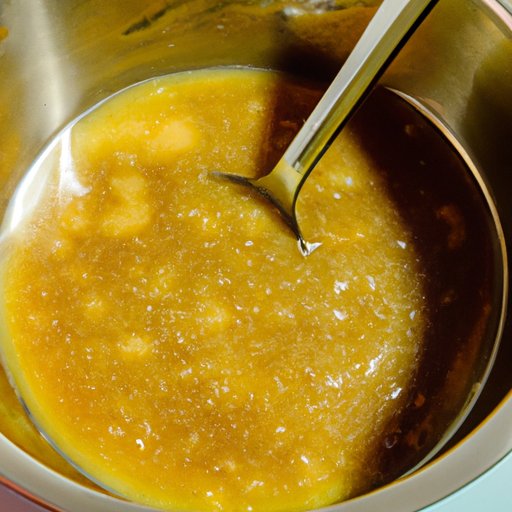
I. Introduction
Roux is an essential ingredient in many cooking traditions, from the creamy béchamel of French cuisine to the spicy gumbo of Creole cooking. It serves as a thickening agent for sauces, gravies, and soups, providing a smooth and silky texture to your dishes. In this article, we’ll explore the art of making roux and dive into the different techniques, ingredients, and cuisines that use this culinary masterpiece.
II. Master the Art of Cooking: A Step-by-Step Guide to Making Roux
The basic ingredients for making roux are simple: flour and fat. The fat can be butter, oil, lard, or any other fat of your choice. The tools you’ll need include a heavy-bottomed pan, a wooden spoon or spatula, and patience.
To make roux, start by melting the fat in the pan over low heat. Gradually add the flour, stirring constantly to prevent lumps from forming. Keep stirring until the mixture turns a pale beige color, then continue cooking until it reaches the desired shade of brown. Remember to be patient – the key to making a good roux is low and slow cooking.
III. Cooking 101: The Basics of Making Roux for Your Favorite Dishes
There are three types of roux: white, blond, and brown. White roux is cooked for the shortest time and used in delicate dishes such as cream sauces. Blonde roux is cooked longer, resulting in a light brown color. It’s commonly used in dishes such as béchamel and mushroom sauces. Brown roux is cooked the longest and has a rich, nutty flavor. It’s commonly used in dishes such as gumbo and jambalaya.
The best way to incorporate roux into your cooking is to experiment with different recipes. You can use roux in dishes such as mac and cheese, gravy, and pan sauces. When adding roux to a dish, it’s important to adjust its thickness by adding more or less of the mixture. The amount of roux you’ll need will depend on the type of dish you’re making and your personal preference.
IV. From Béchamel to Gumbo: Different Roux Techniques for Various Cuisines
The technique for making roux varies depending on the cuisine. French cuisine uses white or blond roux as a thickening agent for soups, béchamel, and other sauces. Creole and Cajun cuisines use brown roux as a base for dishes such as gumbo and jambalaya.
The main differences between the techniques are the ingredients used and the cooking time. French roux is made with butter and flour and is cooked for a shorter time, while Creole and Cajun roux are made with oil and flour and are cooked for a longer time. The resulting roux is also different in texture, with French roux being smoother and lighter in color.
V. The Science of Roux: Understanding the Chemistry Behind Perfectly Creamy Sauces
When you cook flour in fat, the starch in the flour absorbs the fat and expands, creating a smooth and thick consistency. The temperature of the roux determines the thickness of the sauce, with lower temperatures resulting in a thinner consistency and higher temperatures resulting in a thicker consistency.
To prevent lumps from forming in your roux, it’s best to gradually add the flour to the fat while constantly stirring. If lumps still form, you can strain the mixture through a fine-mesh sieve or use a whisk to smooth them out. Remember to stir the roux constantly to prevent it from burning.
VI. The Best Kept Secret of Cajun Cooking: Making Roux from Scratch
Homemade roux is a staple of Cajun cooking and adds a unique flavor to dishes such as gumbo and étouffée. To make a dark roux from scratch, start by heating oil in a heavy-bottomed pan over low heat. Gradually add flour, stirring constantly to avoid lumps. Continue stirring until the roux turns a deep brown color, about 30-45 minutes. The longer the roux is cooked, the stronger the flavor will be.
VII. Tips and Tricks: Perfecting Your Roux-Making Skills for a Deliciously Thickened Sauce
When making roux, it’s important to use a heavy-bottomed pan to prevent burning. You can also add cold liquid to the roux instead of adding it directly to the dish to prevent clumping. Another tip is to adjust the thickness of your roux based on the dish you’re making. If you’re making a creamy sauce, use less roux, and if you’re making a thicker gravy or stew, use more roux.
Finally, remember to experiment with different recipes to perfect your roux-making skills. The more you practice, the easier it will become to create a perfectly thickened sauce for your dishes.
VIII. Conclusion
Roux is an essential ingredient in many traditional dishes and mastering the art of making roux is a valuable skill for any cook. By understanding the different types of roux, techniques, and tips, you’ll be on your way to creating perfectly creamy sauces for any dish. So go ahead and experiment with different recipes, adjust the thickness to your liking, and enjoy the satisfaction of mastering this essential culinary skill.





